10 Resources for Teaching about Genocide
Never forget. Never again. These are common phrases used in Holocaust and genocide education. These are important statements especially when they evoke the real reason to study, learn, and teach about genocide. We must bring this content to students to empower them and encourage them to see beyond themselves. If done right, students become aware of the steps that lead to such atrocities. Teaching about genocide is the only way to have a lasting impact on our students, to affect their worldview, to help them understand that they can make a difference. In my opinion the best way to create this lasting impact is through teaching with testimony.
While listening to survivors students understand the context of genocide at a deeper level.
As an English teacher I taught with testimony to reach my students at a human level because the stories about loving families, unimaginable pain, courageous resistance, catastrophic loss and arduous recovery, allowed them to connect with real people. While listening to survivors’ recollections students understand the context of genocide at a deeper level far beyond the academic lens.
For April’s Genocide Awareness Month explore our 10 recommended IWitness resources to introduce your students to the study of different genocides, individual stories and the universal experience to build an understanding of genocide.
First step register for IWitness
Introduce your students to the themes of genocide through curated clips of testimony. The IWitness Watch page has hundreds of clips on various topics with relatable activities and resources. To access more testimony clips visit the Watch Page – Click on Ethics and Genocide.
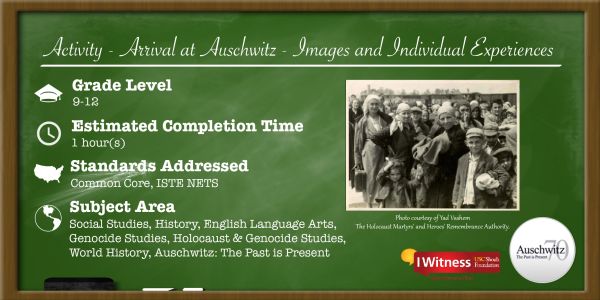
Learning Aims: Students analyze photographs as a primary source, learn how testimony can be used to analyze other primary sources and will be introduced to the Auschwitz Album and its historical context.
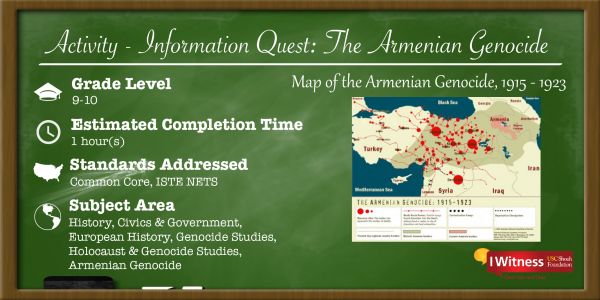
The Armenian Genocide claimed the lives of 1.5 million men, women and children between 1915 - 1923. Through this Information Quest activity, students will learn about the history of the Armenian Genocide, learn to identify the differences between sources of information on the same topic, and recognize the value of multiple perspectives in the learning process.
Learning Aims: Students will engage with testimony using a built-in tool that enables each to construct a word cloud, a fitting title, a meaningful quotation, and a personal response to reflect individual feelings and perceptions about the story.
5. The Genocide against the Tutsi in Rwanda
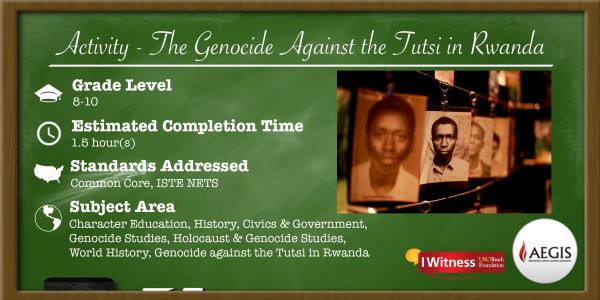
From April to July 1994, one of the most brutal genocides in human history occurred in Rwanda. It claimed the lives of 800,000 men, women and children, most of whom were of Tutsi descent.
The Genocide Against the Tutsi in Rwanda, as the United Nations Security Council agreed it should be known as in January 2014, shared characteristics with other genocides that came before and after it.
Learning Aims: Through this Information Quest activity, students will learn about the history of the Genocide against the Tutsi in Rwanda specifically, the history of genocide generally, and the stages of genocide. They will also be introduced to testimony of eyewitnesses who survived.
6. The Nazi Genocide Against the Roma and Sinti

During the Holocaust, in addition to the genocide perpetrated against the Jews, the Nazis also perpetrated genocide against other groups of people, including the Roma and Sinti (gypsy) people of Europe. The genocide of the gypsies is often referred to as the Porajmos.
Learning Aims: This Mini Quest activity explores the experience of the Roma and Sinti people during the gypsy genocide, which occurred at a number of camps, including Auschwitz-Birkenau.

Learning Aims: Students will watch a number of testimonies from witnesses to and survivors of the Genocide against the Tutsi in Rwanda who describe the consequences of the bystander effect in their own lives. Students will construct a social media message for the #BeginsWithMe campaign that describes their own plan to counter bystander behavior.
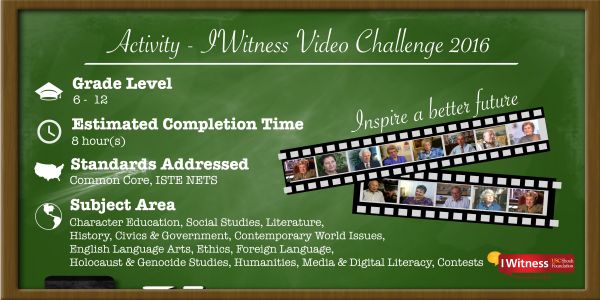
In this activity, students listen to testimonies in IWitness, develop insight into the opportunities for change in their community, get motivated to make a difference and build a video essay telling their story of how they made their community and our world a better place. Additionally the activity introduces students to multiple experiences of genocide including the Armenian Genocide, Genocide against the Tutsi in Rwanda and Holocaust.
Learning Aims: Through this Video Essay activity, students will develop their research skills and their multi-media literacy as they create an action plan, inspired by testimony, to improve their community.
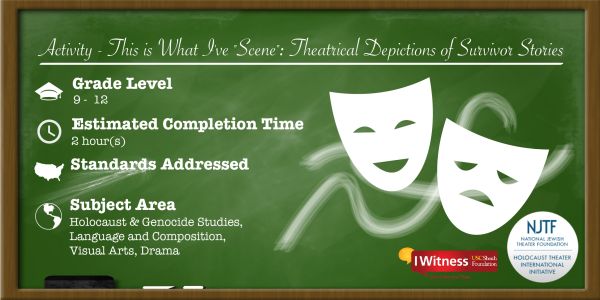
In this Video activity, students develop historical narrative monologues using testimonies of Holocaust survivors, witnesses, and liberators. Students learn how to construct a monologue using a given oral text, and how to dramatically enhance the presentation of that monologue by creating and staging tableaus—or “stage pictures”—which give the monologue added visual interest and help to illuminate the stories.
Learning Aims: Using provided search terms, students will choose video clips from which they will derive their monologues. They will look for stories that speak to them personally, and honor the survivor or witness by sharing his/her story as honestly and as faithfully as they can.
10. Phases of the Final Solution
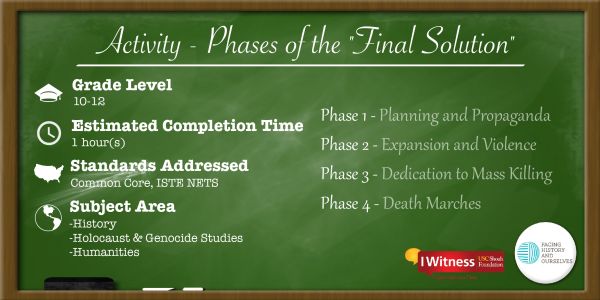
Authored by Facing History and Ourselves, this Information Quest activity explores the chronology of the Holocaust. Based on the work of scholar Doris Bergen, students deepen their understanding of the phases leading to the "Final Solution." The activity combines the work of Professor Bergen, Chancellor Rose and Ray Wolfe Professor of Holocaust Studies at the University of Toronto, and testimonies from the USC Shoah Foundation's Visual History Archive to help students develop their understanding of the processes of the Holocaust as a historical event.
Learning Aims: In this Information Quest, students will consider the work of Professor Bergen and watch several clips of testimonies from Holocaust survivors to build a word cloud that analyzes each phases. Students will develop insight on how primary sources intersect with secondary sources and contribute to our understanding of historical events.
11. Bonus resource: IWitness now includes multiple foreign language activities including in Hungarian, Polish and Czech.
Learn more about teaching with testimony via our Guidelines for Effective Teaching with Testimony.